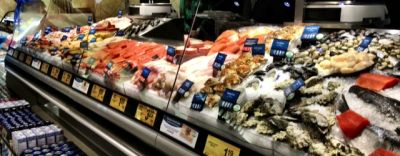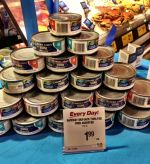Consumers are demanding more and more responsibility and accountability from the people who produce their food, and large companies are starting to respond. While local foods, fair trade goods and organic groceries have been the most recent buzzwords, sustainable seafood is now on the table in a big way. That was the topic of the week’s edition of Food Matters on CBC Victoria’s All Points West.
It certainly hasn’t been an overnight change, but it’s become clear over the past few years that seafood stocks around the world are dwindling. For Canadians we saw it first in a big way with the collapse of the Atlantic cod fishery, and here in BC we are most familiar with shrinking wild salmon populations, but you can also put rockfish and abalone in the same bucket, we haven’t been able to harvest wild abalone since 1990 and rockfish, while still an important part of the BC fishing industry, is being watched very closely with many more harvest restrictions in place now. What has happened in the past with seafood stocks around the world is that as one stock was depleted, the industry would just find another stock to plunder. But now consumers have spoken loudly enough about wanting more sustainable seafood that major retailers are listening.
They are starting to work in conjunction with the various agencies out there that monitor seafood stocks and certify which stocks can be most sustainably harvested. I’ve mentioned some of these agencies in the past. I think here in BC we are most familiar with the OceanWise and SeaChoice programs, but you will also see labels on seafood from the Marine Stewardship Council. A few years ago some of the major grocery chains started to advertise about how they were selling seafood with those certifications, but the announcement I attended last week in Vancouver was one of the most sweeping commitments I’ve seen so far. Canada Safeway announced a partnership with SeaChoice to launch an information program in all of their stores here, complete with a labeling program on the seafood products in each store.
Safeway has adopted most of the ‘stoplight’ system for labeling the SeaChoice features. First or best choice products are have a green label, and a yellow label for second choice or ‘some concerns’ with that particular seafood. Red represents a product that SeaChoice doesn’t recommend you buy, but Safeway is not labeling those choices. I asked SeaChoice representative Kelly Roebuck the reasoning behind that, and she told me that Safeway has phased out many of those ‘red’ products already, or that other products without labels haven’t been rated yet by SeaChoice or other certifying organizations.
So this is still a work in progress… Safeway and SeaChoice started working on this program about two years ago and Safeway has pledged that by 2015 all fresh and frozen seafood, as well as their private label canned tuna, will be sourced from sustainable and traceable sources…or at least be in transition to being sustainable. Renee Hopfner is Canada Safeway’s Director of Community Investment and Corporate Social Responsibility. She told me that the timing was necessary to go through about 30 different seafood vendors Safeway uses, and certify some 25 million pounds of fish that they sell each year used in thousands of different products. Most of the effort has gone into the fresh and frozen side of things, but now they are also looking at canned seafood products, especially since sustainable fresh and frozen products can be pricy.
“So that’s one thing that’s we’ve learned, is that sometimes our sustainable alternatives, because of the supply and demand issue, can be expensive. And so with our canned tuna product, our first foray into the shelf-stable category, we’re really excited that it’s an affordable alternative for our customers, because it is a Safeway-branded product.”
The Safeway brand canned tuna comes complete with labeling that tells you the tuna was caught without using harmful ‘fish-aggregating-devices’ or FADs, which have been linked to detrimental occurrences of by-catch to more fragile species.
Some of the more difficult products to source sustainably are shrimp and farmed salmon. I’ve talked in the past about how much of the very cheap shrimp we eat in North America comes from very non-sustainable practices and it’s an area they are still working on but they are pretty sure they can have something in place by 2015, or at least be on the road to it. They have also managed to secure some salmon that has been farmed in a closed-containment system which is deemed a better choice by SeaChoice. The only problem with that is keeping up with the demand, when people see it in the stores, they’re buying it. That’s just one more sign of the change that is happening with consumers that retailers and suppliers are dealing with.
If any one company can send ripples through a supply chain it is McDonald’s. In Canada, the chain has already been using Alaskan Pollock for its sandwiches for a while, which is on the Marine Stewardship Council’s safe list, and now all the McDonald’s in the USA will be using MSC certified fish in their Filet O Fish sandwiches as well as something new called Fish McBites, which will debut in February. They will even put the MSC blue certification labels on the packaging.
Is there any downside to all of this attention being paid to sustainable stocks? I worry about there being too much pressure put on what are so-called sustainable stocks as demand for these products increases. And I worry about the accuracy of the certification. A report in the Marine Policy journal states that some 31 percent of the fish stocks certified by the MSC had indeed been overfished! That report has contributed to a growing controversy about how seafood stocks are indeed certified.
OPPORTUNITY: The Victoria Public Market at the Hudson is slated to open on May 1st, 2013. This market will draw plenty of tourists and it is assembled to serve everyday grocery shoppers with such vendors as a butcher, baker, cheese maker, and produce dealer as well as other prepared food. One key vendor that is missing is seafood. Maryanne Carmack of the Victoria Downtown Public Market Society says that. “It’s essential we have seafood as an option in our Public Market. Customers want to have a one stop shop for all of their needs and they demand variety. I would love a place where I can buy a whole fish or try something different such as a fresh sardine.” If you are interested in this opportunity, send me a note at don at don genova dot com and I will put you in touch with Maryanne!
***This just in… today SeaChoice announced another partnership with Buy-Low Foods, which includes both Nesters Market and Shop n’ Save stores.
To listen to this or past Food Matters episodes, visit this page at the All Points West website.





Hi Don, I would love to talk with you more sometime about farmed B.C. salmon. You briefly mention it in this post, but I think it deserves more mention. It’s a B.C. product, farmed around Vancouver Island, and is about as local as you can get. I understand there are some concerns about farmed salmon but I believe many of them are based on old information, not the current state of salmon farms. I would welcome a discussion with you about this.